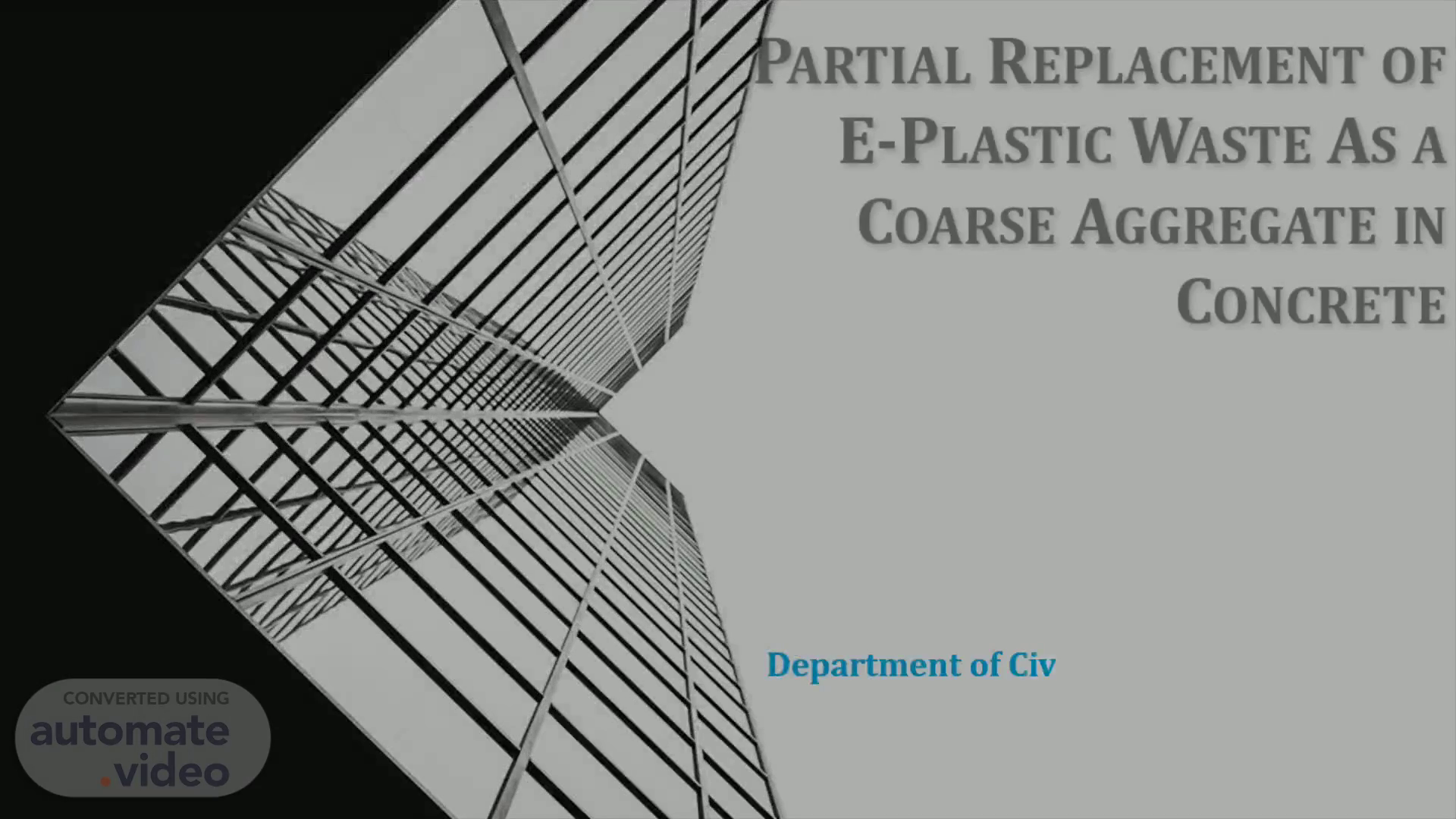
Partial Replacement of E-Plastic Waste As a Coarse Aggregate in Concrete
Scene 1 (0s)
Partial Replacement of E-Plastic Waste As a Coarse Aggregate in Concrete.
Scene 2 (9s)
GROUP MEMBERS NAMES. SYED MUZAMMIL AHMED FA19-CVE-047 ABDULLAH AFTAB FA19-CVE-035 MALIK M. TALHA FA19-CVE-054 SUPERVISED BY : MR. RAJA TASSADUQ (Lecturer , Civil Engineering Department, Wah Campus).
Scene 3 (23s)
SCHEME OF PRESENTATION. PRE TEXT AIM OF STUDY INTRODUCTION OBJECTIVES METHADOLOGY MATERIALS MATERIAL PROPERTIES EXPERIMENTAL PLAN MIX DESIGN SAMPLE PREPARATION RESULTS AND DISCUSSION CONCLUSION FUTURE RECOMMENDATION.
Scene 4 (34s)
Problem Statement. Traditional concrete production heavily relies on the extraction of natural coarse aggregate, leading to environmental degradation and depletion of finite resources. Moreover, the improper disposal of plastic waste poses a significant challenge to sustainable waste management. Therefore, there is a critical need to explore alternative solutions that address both the environmental impact of coarse aggregate extraction and the management of plastic waste. This project aims to investigate the feasibility and performance of replacing traditional coarse aggregate with e-plastic waste in concrete, offering a sustainable and innovative approach to construction materials..
Scene 5 (1m 0s)
E-waste, refers to electrical or electronic devices that have been disposed of . It includes used electronics that are meant for reuse, resale, reclamation, recycling, or disposal. Electronic waste is an Engineering Issue which is causing serious pollution problem to the human and environment. The disposal of waste comprise as one of major worldwide environmental problems as these wastes render the environment unfriendly..
Scene 6 (1m 30s)
AIM :. The aim of our FYP is to produce environmental friendly, cheap and light weight concrete . Aim of the mix design is to achieve the good quality concrete. Quality concrete means better strength and durability..
Scene 7 (1m 44s)
INTRODUCTION. Concrete is the basic engineering material used in most of civil engineering structures. E plastic waste management and recycling is quickly expanding since it is a lucrative resource for IT businesses, as well as a very toxic product with a low recycling rate. Utilization of E Plastic waste is the partial solution to environmental and ecological problems This waste consists of discarded old computers, TV's radios etc. These Plastics are non biodegradable plastic wastes and used as partial replacement of Coarse Aggregate..
Scene 8 (2m 5s)
OBJECTIVES. In this experiment, e plastic wastes to be used as a partial replacement of the concrete ingredient (i.e.) Coarse Aggregates. The mechanical properties are to be measured for the designed concrete specimen. Mechanical properties are : Compressive Strength. Split Tensile Strength. Flexural Strength..
Scene 9 (2m 22s)
Methodology. MATERIAL COLLECTION. SAMPLE PREPARATION.
Scene 10 (2m 34s)
Materials to be used. NaturalSand FAUJI CEMENT NATURAL AGGREGATES E-WASTE WATER.
Scene 11 (2m 53s)
MATERIAL PROPERTIES. Fauji Cement Company Limited (FCCL): Result review FCCL 3QFY20 LPS at Rs0.15 – By Foundation Research.
Scene 12 (3m 23s)
EXPERIMENTAL PLAN. E Plastic waste is collected from the local vendor in Rawalpindi. After that it is then shredded into pieces by a crushing machine so that it can use in replacement of coarse aggregate in concrete. The ratio used in the study is 1: 2: 4 and w/c ratio is 0. 5 . Concrete mixes were produced by replacing 0, 25, 50 and 75% as coarse replacement . Cylinders and beams were casted for compressive, tensile and flexural strength determined at 7 and 28days..
Scene 13 (3m 47s)
MIX DESIGN. Concrete mixes were prepared by using e plastic as partial replacement of coarse aggregate ranges from 0 to 75% by volume. The machine mixing technique was used for this research work..
Scene 14 (4m 8s)
SAMPLE PREPARATION. SAMPLING. MIXING. SLUMP TEST.
Scene 15 (4m 20s)
RESULTS AND DISCUSSION. COMPRESSIVE STRENGTH TEST :.
Scene 16 (4m 40s)
RESULT AND DISCUSSION. SPLIT TENSILE STRENGTH TEST :.
Scene 17 (5m 2s)
RESULT AND DISCUSSION. FLEXURAL STRENGTH :. NORMAL CONCRETE 25% REPLACEMENT (Mpa) 50% REPLACEMENT (Mpa) 75% REPLACEMENT (Mpa) 1.58 1.083 0.73899999999999999 0.43.
Scene 18 (5m 15s)
CONCLUSION :. At 25 % replacement, Compressive Strength was almost same to Conventional Concrete strength and then it decreases with the increase in e plastic content. It was noted that the compressive strength decreases with the increase in E plastic content. Tensile strength test was conducted after casting and curing at 7 and 28 days. Same as the compressive strength it also decreases with the increase in e plastic content. Flexural strength test was conducted after casting and curing of beam, and it was noted that the flexural strength decreases with the in crease in e plastic content..
Scene 19 (5m 41s)
Future recommendations. The effect of adding different mineral admixture in concrete containing e-plastic coarse aggregates, can also be considered Use of e-plastic aggregates in concrete as replacement of natural coarse aggregate is also interesting for future research. Chemical testing and thermal resistance of concrete containing e-plastic aggregates should also be done. Different percentages of admixtures can also be used to enhance the strength of e-plastic aggregate concrete..